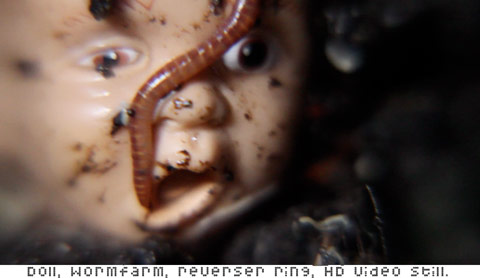
DSLR cameras extend the possibilities of macro (close-up) photography to video. Aside from the expensive macro lens options, there are a range of super-cheap DIY modifications available, that let you capture miniature worlds in motion.
All below are cheap options, and can be frowned upon by photography purists – you’ll lose some of your camera controls ( eg autofocus), but when used for DSLR video, image quality is still fantastic compared to traditional video cameras in the same price range, and really, you’re swimming in miniature worlds, and potentially capturing them in HD video.
Macro Conversion Lenses
Option one – find out what diameter size your lense is ( it’ll look like this on the lens – Ø72, meaning 72mm ), then buy a cheap lens add on magnifier of the same diameter that will screw on. An Ebay search for ‘macro lens kit’ will deliver a cheap collection of lenses with a variety of magnifications.
Reverser Rings
Again, the diameter of your lens is needed her, and when you flush the reverser ring search through Ebay, a small package will arrive from Hong Kong in a week or so. The reverser ring attaches to the front of the lense, which let’s the lens go onto the camera backwards. (Or DIY Reverser ring )
Extender Tubes
These cheap metal cylinders extend the distance your camera’s innards and the end of the lense, enabling a closer minimal focal distance for shooting from.
Bellows
There’s something perversely analogue and satisfying about these, kind of like attaching a small piano accordion to your digital pixel capture magic box. They allow easy fine tuned adjustments, moving the lens with respect to the focal plane for focusing. ( Crazier, more expensive tilt-shift bellows option, with full Canon EOS controls retained by camera: Novoflex have you covered.)
Or You Could Just Use
A Pringles can. And aye, naturally, there are many DIY iphone macro photography tutorials ( eg Instructables ). Mostly they involve magnifying glasses of some sort in front of the camera lense. Or maybe a video endoscope‘s more your flavour?
Challenges?
Depth of field will be a problem. Even very, very small movements with the camera will take objects in and out of focus. Stability is key then, and DIY stages / environments for objects, even better. Lighting can also be a problem, both in terms of having the camera so close to the object, and with the extra lense lengths being added, letting less light through to the camera. This can be solved with ring lights which fit around a lens, or thoughtful side lighting / reflected light.
Be off swimming with the micro-beasties now, won’t you?

That’s why we’re taking a look at the best free photo-editing software on the market, each of which provides much of the same functionality as Photoshop but without the associated fees.